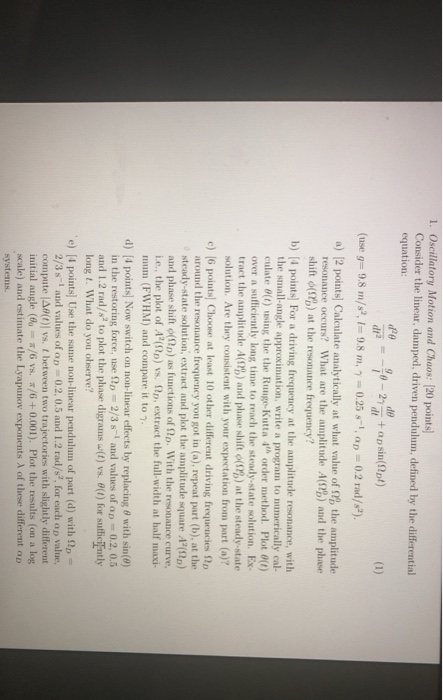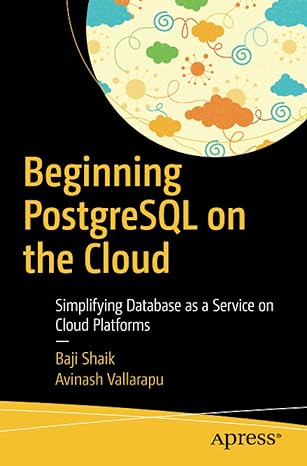Answered step by step
Verified Expert Solution
Question
1 Approved Answer
pls solve part e 1. Oscillatory Motion and Chaos: (20 points) Consider the linear, damped, driven pendulum, defined by the differential equation de 0.25 s-,
pls solve part e  1. Oscillatory Motion and Chaos: (20 points) Consider the linear, damped, driven pendulum, defined by the differential equation de 0.25 s-, a) [2 points] Calculate analytically at what value of ng, the amplitude dt2 (use g# 9.8 m/s2, l 9.8 m. aD-0.2 rad/s2). resonance occurs? What are the amplitude A( shift corn) at the resonance frequency? ) and the phase b) [4 points] For a driving frequency at the amplitude resonance, with the small-angle approximation, write a program to mumerically cal- culate 0(t) using the the Runge-Kutta 4th order method. Plot () over a sufficiently long time to reach the steady-state solution. Ex tract the amplitude A(f%) and pliise shift o(%) at the steady-state solution. Are they consistent with your expectation from part (a) c) [6 points! Choose at least 10 other different driving frequencies around the resonance frequency you got in (a), repeat part (b), at the steady-state solution, extract and plot the amplitude square A2() and phase shift o(Rp) as functions of 2p. With the resonance curve, ie, , the plot of A2(QD) vs. D, extract the full-width at half maxi- mum (FWHM) and compare it to 7 d) [4 points] Norw switch on non-linear effects by replacing with sin(0) in the restoring force, use p 2/3 s-1 and values of op-0.2,0.5 and 1.2 rad/s2 to plot the plate digrams w(t) vs. 67(1) for suffic ntly long t. What do you observe? e) [4 points] Use the same non-linear pendulum of part (d) with 2p 2/3 s 1 and values of op 0.2,0.5 and 1.2 rad/s2, for each ap value, compute |AO)vs. t between two trajectories with slightly different initial angle (60-x/6 vs. /6 + 0.001). Plot the results (on a log scale) and estimate the Lyapunov exponents of these differe!t au systems 1. Oscillatory Motion and Chaos: (20 points) Consider the linear, damped, driven pendulum, defined by the differential equation de 0.25 s-, a) [2 points] Calculate analytically at what value of ng, the amplitude dt2 (use g# 9.8 m/s2, l 9.8 m. aD-0.2 rad/s2). resonance occurs? What are the amplitude A( shift corn) at the resonance frequency? ) and the phase b) [4 points] For a driving frequency at the amplitude resonance, with the small-angle approximation, write a program to mumerically cal- culate 0(t) using the the Runge-Kutta 4th order method. Plot () over a sufficiently long time to reach the steady-state solution. Ex tract the amplitude A(f%) and pliise shift o(%) at the steady-state solution. Are they consistent with your expectation from part (a) c) [6 points! Choose at least 10 other different driving frequencies around the resonance frequency you got in (a), repeat part (b), at the steady-state solution, extract and plot the amplitude square A2() and phase shift o(Rp) as functions of 2p. With the resonance curve, ie, , the plot of A2(QD) vs. D, extract the full-width at half maxi- mum (FWHM) and compare it to 7 d) [4 points] Norw switch on non-linear effects by replacing with sin(0) in the restoring force, use p 2/3 s-1 and values of op-0.2,0.5 and 1.2 rad/s2 to plot the plate digrams w(t) vs. 67(1) for suffic ntly long t. What do you observe? e) [4 points] Use the same non-linear pendulum of part (d) with 2p 2/3 s 1 and values of op 0.2,0.5 and 1.2 rad/s2, for each ap value, compute |AO)vs. t between two trajectories with slightly different initial angle (60-x/6 vs. /6 + 0.001). Plot the results (on a log scale) and estimate the Lyapunov exponents of these differe!t au systems
1. Oscillatory Motion and Chaos: (20 points) Consider the linear, damped, driven pendulum, defined by the differential equation de 0.25 s-, a) [2 points] Calculate analytically at what value of ng, the amplitude dt2 (use g# 9.8 m/s2, l 9.8 m. aD-0.2 rad/s2). resonance occurs? What are the amplitude A( shift corn) at the resonance frequency? ) and the phase b) [4 points] For a driving frequency at the amplitude resonance, with the small-angle approximation, write a program to mumerically cal- culate 0(t) using the the Runge-Kutta 4th order method. Plot () over a sufficiently long time to reach the steady-state solution. Ex tract the amplitude A(f%) and pliise shift o(%) at the steady-state solution. Are they consistent with your expectation from part (a) c) [6 points! Choose at least 10 other different driving frequencies around the resonance frequency you got in (a), repeat part (b), at the steady-state solution, extract and plot the amplitude square A2() and phase shift o(Rp) as functions of 2p. With the resonance curve, ie, , the plot of A2(QD) vs. D, extract the full-width at half maxi- mum (FWHM) and compare it to 7 d) [4 points] Norw switch on non-linear effects by replacing with sin(0) in the restoring force, use p 2/3 s-1 and values of op-0.2,0.5 and 1.2 rad/s2 to plot the plate digrams w(t) vs. 67(1) for suffic ntly long t. What do you observe? e) [4 points] Use the same non-linear pendulum of part (d) with 2p 2/3 s 1 and values of op 0.2,0.5 and 1.2 rad/s2, for each ap value, compute |AO)vs. t between two trajectories with slightly different initial angle (60-x/6 vs. /6 + 0.001). Plot the results (on a log scale) and estimate the Lyapunov exponents of these differe!t au systems 1. Oscillatory Motion and Chaos: (20 points) Consider the linear, damped, driven pendulum, defined by the differential equation de 0.25 s-, a) [2 points] Calculate analytically at what value of ng, the amplitude dt2 (use g# 9.8 m/s2, l 9.8 m. aD-0.2 rad/s2). resonance occurs? What are the amplitude A( shift corn) at the resonance frequency? ) and the phase b) [4 points] For a driving frequency at the amplitude resonance, with the small-angle approximation, write a program to mumerically cal- culate 0(t) using the the Runge-Kutta 4th order method. Plot () over a sufficiently long time to reach the steady-state solution. Ex tract the amplitude A(f%) and pliise shift o(%) at the steady-state solution. Are they consistent with your expectation from part (a) c) [6 points! Choose at least 10 other different driving frequencies around the resonance frequency you got in (a), repeat part (b), at the steady-state solution, extract and plot the amplitude square A2() and phase shift o(Rp) as functions of 2p. With the resonance curve, ie, , the plot of A2(QD) vs. D, extract the full-width at half maxi- mum (FWHM) and compare it to 7 d) [4 points] Norw switch on non-linear effects by replacing with sin(0) in the restoring force, use p 2/3 s-1 and values of op-0.2,0.5 and 1.2 rad/s2 to plot the plate digrams w(t) vs. 67(1) for suffic ntly long t. What do you observe? e) [4 points] Use the same non-linear pendulum of part (d) with 2p 2/3 s 1 and values of op 0.2,0.5 and 1.2 rad/s2, for each ap value, compute |AO)vs. t between two trajectories with slightly different initial angle (60-x/6 vs. /6 + 0.001). Plot the results (on a log scale) and estimate the Lyapunov exponents of these differe!t au systems

Step by Step Solution
There are 3 Steps involved in it
Step: 1

Get Instant Access to Expert-Tailored Solutions
See step-by-step solutions with expert insights and AI powered tools for academic success
Step: 2

Step: 3

Ace Your Homework with AI
Get the answers you need in no time with our AI-driven, step-by-step assistance
Get Started


